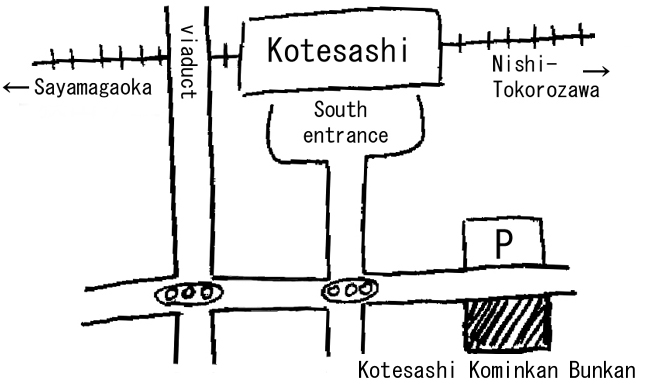Introduction of Musashino sword club
We have a meeting every 2 months in Tokorozawa city Saitama prefecture.
In the 6 time meeetings, we have a Kantei game. Usually, the lecturer is
Mr. Takayama. The unique point of this club is the quality of the swords
for kantei game. Usually we study 5 swords, and 1 or 2 of them are very
high quality like Ko-bizen or Ichimonji those are only found in museums.
Members challenge the game quietly and seriously. The quality of swords
is very high and the behaviour of members is serious. So sword lovers gather
from large area. "Musashino" means an area around Tokyo and Saitama.
Member fee is 10,000.yen par year. Member is free for the meetings.
Non-member (visitor) is 2,000.yen for one meeting.
Place; Kotesashi Kominkan Bunkan. Walk 400m from the Kotesashi stationon
on the Seibu-Ikebukuro line.
Hour; 6:00PM ~ 9:00PM
Usually the meeting is made of 10 ~ 15 persons, half are members and half
are visitors.
You are welcome to visit our club, if you have a chance to come. Kokaji
is a practical manager of the club, and will treat you as sword lover.

Manner of Kantei game in the Musashino sword club
The game of our club keeps some classical style in Samurai age. So, I wonder
if it is a little uncomfortable for beginners, but good for study swords
seriously.
Usually the room is a tatami floor. Tables are settled, and covered with
cloths. Several swords with hilt are put on the table using a small pillow.
Light stands are settled on the wall. This situation is not different to
other sword clubs.
When you study sword, you should sit with square style (Seiza). If you
need an easy sitting style, you should ask to the lecturer previously.
Sit before the sword, then make a light bow against the sword to show your
respect to old sword. You never speak while studying the sword.
Take the sword in your hand. Never touch the blade.
The way of study is, studying the shape, then steel, then hamon.
1) Studying shape. Hold the handle vertically with your right hand stretching
your arm. The blade is set the back on left and the edge on right. You
study the shape looking at the blade from the bottom toward the tip, and
from the tip toward the bottom.
2) Studying steel. Turn your body a little right side, and hold the sword
close to you. The kissaki should be set toward the frontal wall. With this
style, you can study the steel safely. You can also study the bevel meat.
3) Studying hamon. You turn again toward the front. You take the light
to reflect it on blade surface. The hamon comes up brightly. Relax your
arm to find a proper angle between the blade and the light. Be careful,
not to swing the blade right or left. You have to keep the kissaki toward
the front. When you study the hamon in kissaki, you can use the cloth that
put beside the sword. Take the close in your left hand, and put the kissaki
on it to take the kissaki close to you.
Careful behaviour is good for safety studying. And quick study is necessary
to consider the next person who sits behind of you. Do not think there.
Just study and remember. You can think to find the smith later.
When you finish studying the blade, put the blade carefully on the table
again. Then make a light bow again. Then leave the seat.
Around the tea tables at the other side in the room, people are thinking
and writing their papers. You don't ask or speak smith's name or school.
Each of members are studying to themselves seriously. This situation may
be different from other local clubs. In some other clubs, members discuss
and chat to find out the smith's name. The members of Musashino are more
serious. They keep quiet until the tang is opened. This is The point of
the manner from Samurai age. This game is a study, as well as an enjoyable
play.
Write the examine paper. You write the smith's name as your question to
the lecturer. That means, you think so and how your opinion is. You submit
the paper to the lecturer, sitting before him and say "Onegai shimasu".
Then the lecturer write the answer and score. You receive it sitting before
him again, and say "Arigatou gozaimasu". The voice can be small,
because the room is silent. If your question gets the smith himself or
very close one, your question ends and gets some score. If you have not
get the correct smith, lecturer's answer suggests the way how to think
the next.
The score is not important, but what you find on the blade and how you
think to reach the smith is important. Usually we can make three times
question for each sword until you find the correct smith.
After the time up, the tang is opened, and lecturer makes a lecture for
each sword. Then we study the tang again.
Home
